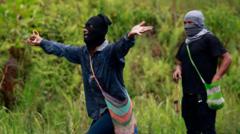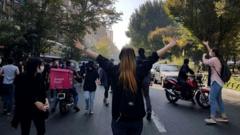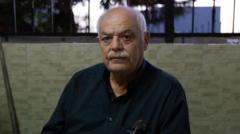**In a remarkable operation, Brazilian police thwarted a bomb attack intended for Lady Gaga's performance at Copacabana beach, arresting two individuals and emphasizing the growing concerns around extremism among youth.**
**Brazilian Authorities Prevent Bomb Plot Targeting Lady Gaga's Concert**

**Brazilian Authorities Prevent Bomb Plot Targeting Lady Gaga's Concert**
**Police arrest suspects linked to planned attack during star-studded event in Rio de Janeiro**
In an alarming incident, Brazilian police successfully thwarted a planned bomb attack aimed at Lady Gaga's concert held at Copacabana beach in Rio de Janeiro on Saturday. This event witnessed a crowd of over two million attendees, drawn in by the allure of the star-studded performance, which was free for the public.
The operation, coordinated by the Civil Police of Rio de Janeiro alongside the justice ministry, led to the arrest of the alleged mastermind behind the plot and a teenager believed to be involved. Identified through a surge of information from local police intelligence, the suspects had been recruiting individuals to execute attacks using improvised explosives, spurred by a desire to gain visibility on social media platforms.
Reports reveal that the group had a history of disseminating hate speech, particularly targeting children, adolescents, and the LGBTQIA+ community. The mastermind of the operation was apprehended in Rio Grande do Sul on charges of illegal firearm possession, while the teenager faced detention for storing explicit material involving minors in Rio.
Amid rising tensions, the suspects appeared to pose as Lady Gaga fans, often referred to as "Little Monsters." The police undertook extensive searches across multiple Brazilian states, including Rio de Janeiro and São Paulo, seizing electronic devices and materials linked to radicalization efforts directed at teenagers.
Dubbed "Operation Fake Monster," the investigation highlighted the dangers of online extremism, where coded language and violent imagery lured young individuals into a culture of self-harm and aggression.
In an effort to bolster local tourism and commerce, the city funded the concert, anticipating significant economic benefits estimated at $100 million (£75 million). Ensuring a safe environment for attendees, authorities deployed 5,000 officers and utilized advanced security measures, including metal detectors, drones, and facial recognition technology to monitor the event closely.
The operation, coordinated by the Civil Police of Rio de Janeiro alongside the justice ministry, led to the arrest of the alleged mastermind behind the plot and a teenager believed to be involved. Identified through a surge of information from local police intelligence, the suspects had been recruiting individuals to execute attacks using improvised explosives, spurred by a desire to gain visibility on social media platforms.
Reports reveal that the group had a history of disseminating hate speech, particularly targeting children, adolescents, and the LGBTQIA+ community. The mastermind of the operation was apprehended in Rio Grande do Sul on charges of illegal firearm possession, while the teenager faced detention for storing explicit material involving minors in Rio.
Amid rising tensions, the suspects appeared to pose as Lady Gaga fans, often referred to as "Little Monsters." The police undertook extensive searches across multiple Brazilian states, including Rio de Janeiro and São Paulo, seizing electronic devices and materials linked to radicalization efforts directed at teenagers.
Dubbed "Operation Fake Monster," the investigation highlighted the dangers of online extremism, where coded language and violent imagery lured young individuals into a culture of self-harm and aggression.
In an effort to bolster local tourism and commerce, the city funded the concert, anticipating significant economic benefits estimated at $100 million (£75 million). Ensuring a safe environment for attendees, authorities deployed 5,000 officers and utilized advanced security measures, including metal detectors, drones, and facial recognition technology to monitor the event closely.























